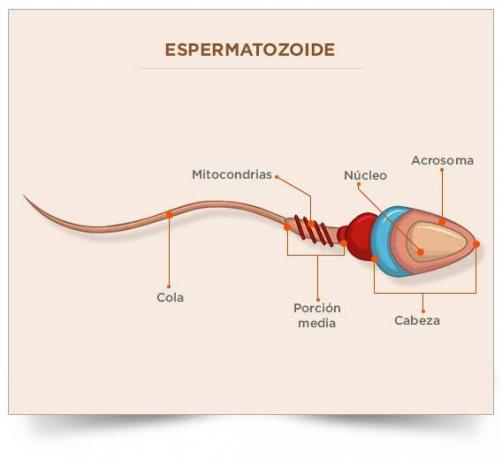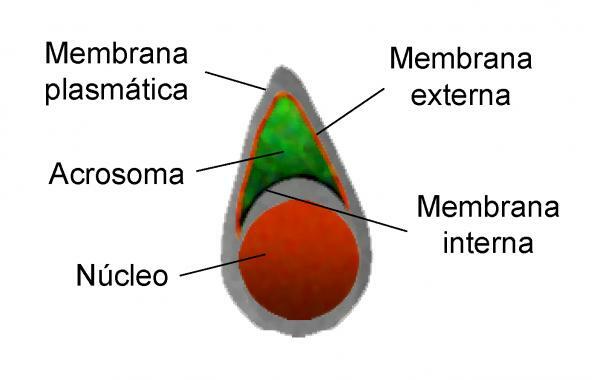Discover ALL the parts of the sperm

Image: Health and Medicines
One of the most important functions of living beings is the reproduction. In beings with sexual reproduction, in order for it to be carried out, the female gamete (ovum) and the male gamete (sperm) are required to intervene. These cells have a common function, although their appearance and parts are different. In another lesson of a TEACHER we already did a review of the parts of an ovule, so here we will see what are the parts of the sperm.
Index
- Sperm: simple definition
- The head, one of the parts of the sperm
- The neck or middle piece
- The tail or flagellum
- The plasma membrane
- The parts of the sperm, can they change?
Sperm: simple definition.
The sperm is the male sex cell or male gamete. He is in charge of the passage of the father's genetic information to their children and, unlike the ovum, it does not intervene in the nutrition of the embryo. Sperm is a small cell, specially designed to have a lot of mobility and to be able to overcome all obstacles until reaching the ovum.
Remember that, for the fertilizationProperly, the sperm and egg have to meet in the fallopian tube, so the sperm has to make its way there.
In order to carry out its function we can distinguish different parts of the sperm: the head, the neck or intermediate piece and the tail or flagellum, all of them covered by the plasma membrane. Each of the parts of a sperm has different components and is specialized in a function that we will see in the following sections.

Image: Taringa!
The head, one of the parts of the sperm.
The head is the part of the sperm in charge of save paternal DNA until fertilization occurs. Inside the head we can distinguish two parts: the nucleus and the acrosome.
- The acrosome it occupies the front two-thirds of the sperm head. This layer is made up of substances called enzymes. In this case, these enzymes are responsible for eliminating a layer of substances from the ovum - called zona pellucida- when fertilization occurs.
- The core (or male pronucleus) contains the genetic makeup of the sperm. Like the ovum, the sperm is a sex cell or gamete, so it has half the chromosomes of the rest of the cells in our body (somatic cells). These types of cells with half the chromosomes are called cells. haploid and they are specially designed so that, when uniting in fertilization, a cell with the normal number of chromosomes (zygote) is created, which carries DNA from both the ovum and the sperm.

Image: Assisted Reproduction ORG
The neck or middle piece.
The neck or intermediate piece is another part of the sperm. It is a small region of the sperm that is found between head and tail.
Inside are the mitochondria, very important organelles that provide energy to the sperm. The sperm needs a lot of energy to make its way from the cervix, through the uterus to the fallopian tubes, where it meets the ovum to fertilize it.
In addition, in the neck there are also a series of structures (centrioles) that allow the tail to anchor to the head and have mobility.

Image: SlidePlayer
The tail or flagellum.
The tail or spermatic flagellum is a long, whip-like structure, the main purpose of which is to allow sperm move through the different parts of the female reproductive tract until the ovum is fertilized. The sperm has a meandering movement of about 3 millimeters per minute which, considering its size, is… very fast!
The part of the flagellum closest to the neck of the sperm may be slightly thickened and become thinner and thinner. For this reason, there are some authors who distinguish between this thickened area (main piece) and the most final part of the flagellum (final piece). Both parts have the same function, to allow the movement of the sperm.
The plasma membrane.
Surrounding the head, neck and tail of the sperm is a very small amount of cytoplasm and the plasma membrane. The plasma membrane of sperm covers the entire head and body of the sperm, uniting and protecting them.
In addition to protection, the composition of the membrane - rich in polyunsaturated fatty acids - is specially designed to be flexible so that the sperm can be highly mobile.

Image: Hormones
The parts of the sperm, can they change?
The parts of the sperm they keep changing. During its formation, through a series of changes called spermatogenesis, the cell that gives rise to the sperm keeps changing until it has the appearance and the parts that we have seen. The cell that gives rise to sperm does not have, for example, a tail and has to gradually change and develop that tail to allow the sperm to reach the egg.
It is very important that sperm have all these parts and that they all work properly. In some cases, the sperm may have failures or alterations that prevent them from reaching the ovum or that if they arrive, the DNA that carries the nucleus of the head has been damaged or degraded. In this case, the zygote that forms at fertilization is not correct and will not form an embryo.
Do you want to know more about what happens to sperm during fertilization? Take a look at our post about phases of fertilization. Have a suggestion, comment, or question about cell division? We'd love to read you in the comment section!
If you want to read more articles similar to Sperm parts, we recommend that you enter our category of biology.
